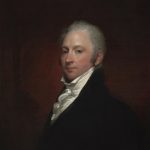
Bringing forth unknown or obscure early southern artists and artisans through their work and the historical record is fundamental to the mission of the MESDA Journal. The articles presented in the 2018 issue fully reflect this purpose. Some authors engage an object to reveal a previously unrecognized artist, as in the case of Laurel Horton’s article about the Eastern North Carolina embroiderer Polly Armistead. Others scour primary and secondary documents to identify craftspeople for which no product from their shops survive, as Stephen Compton does in his work on the potters working in eighteenth-century Salisbury, North Carolina.
Katie McKinney’s meticulous research on the artist William Roberts uses both his paintings and prints as well as primary documents to build on Barbara Batson’s seminal 1984 article on Roberts’s work. Extraordinarily, Katie was able to locate a previously unrecognized travel journal that details Roberts’s journey through Virginia to sketch the Natural Bridge and Harper’s Ferry, two of the natural monuments central to Thomas Jefferson’s efforts in creating an identity for the young American Republic.
Masterfully crafted longrifles and powder horns allow Mel Hankla to bring to light the talent of gunsmiths Jacob Young and Thomas Simpson. As important, Mel’s work reminds us today of the unique and forgotten region known as the Cumberland. Neither Tennessee nor Kentucky, the Cumberland was an integral place on the early southern frontier best understood today through the people and things that inhabited its wilderness.
The articles of the 2018 MESDA Journal explore textiles, paintings, rifles, and pottery and the men and women who made them. From Virginia down to coastal Carolina out through the Piedmont into the wilderness of the Cumberland, there is something to be found for anyone interested in the people and things that made up the cultural landscape of the early American South.
Happy reading!
With best regards,

Gary Albert
Editor
[email protected]
